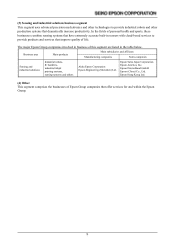Epson 2015 Annual Report Download - page 20
Download and view the complete annual report
Please find page 20 of the 2015 Epson annual report below. You can navigate through the pages in the report by either clicking on the pages listed below, or by using the keyword search tool below to find specific information within the annual report.
19
of our most important management policies, and we proactively engage in environmental conservation efforts
on a variety of fronts, in line with “Environmental Vision 2050” and our mid-range action plans. For example,
we have programs to develop and manufacture products that have a small environmental footprint. We also have
programs to reduce energy use, promote the recovery and recycling of end-of-life products, ensure compliance
with international substance regulations (primarily the RoHS Directive and REACH regulations in the EU), and
improve environmental management systems. Thanks to these efforts, we have not had any serious
environmental issues to date. In the future, however, it is possible that an environmental problem could arise
that would require us to pay damages and/or fines, bear costs for cleanup, or force a halt of production.
Moreover, new regulations could be enacted that would require major expenditures, and, if such a situation
should occur, Epson’s operating results could be adversely affected.
10. Epson faces risks concerning the hiring and retention of personnel.
We must hire and retain talented personnel both in Japan and overseas to develop advanced new technologies
and manufacture advanced new products, but the competition for such personnel is becoming increasingly
intense. We must hire and retain talented personnel by, for example, introducing compensation and benefit
packages that are commensurate with roles and by proactively promoting people with the right skills overseas.
If we are unable to continue to hire and keep enough of such employees, or if we are unable to pass along
technologies and skills, we could find it difficult or impossible to execute our business plans.
11. Fluctuations in foreign currency exchanges create risks for Epson.
A significant portion of our revenue is denominated in U.S. dollars or the euro. We expanded our overseas
procurement and moved our production sites overseas, causing our dollar-denominated expenses to rise, and
although our dollar-denominated revenue and expenses are more or less counterbalanced, our euro-denominated
revenue is still greater than our euro-denominated expenses. Also, although we use currency forwards and other
means to hedge against the risks inherent in foreign currency exchanges, unfavorable movements in the
exchange rates of foreign currencies such as the U.S. dollar or euro against the yen could adversely affect our
financial situation and financial results.
12. There are risks inherent in pension systems.
We have a defined-benefit pension plan and a lump-sum payment on retirement as defined-benefit plans.
We revised the defined-benefit retirement pension plan in April 2014 in response to a drop in the rate of return
on pension assets and an increase in the number of beneficiaries. The revisions are designed to enable us to
adapt to future market changes and maintain stable operations into the future. However, if there is a change in
the operating results of the pension assets or in the ratio used as the basis for calculating retirement allowance
liabilities, our financial position and operating results could be adversely affected.
13. Epson is vulnerable to proceedings relating to antitrust laws and regulations.
With business operations that span the globe, Epson is subject in Japan and overseas to proceedings relating to
antitrust laws and regulations, such as those prohibiting private monopolies and those protecting fair trade.
Overseas authorities sometimes investigate or gather information on certain industries and, in conjunction with
this, Epson’s market conditions and sales methods may come under investigation. Such investigations and
proceedings, or violations of applicable statutes, could interfere with our sales activities. They could also
potentially damage Epson’s credibility or result in a large civil fine. Any of these could adversely affect our
operating results.
Seiko Epson and certain of its consolidated subsidiaries are currently under investigation by the European
Commission and other anti-trust law regulatory authorities regarding allegations of involvement in a liquid
crystal display price-fixing cartel. It is difficult at this time to predict the outcome of these investigations and
when they may be settled.
14. Epson is at risk of material legal actions being brought against it.
Epson conducts businesses internationally. We are engaged primarily in the development, manufacture and sale
of printing solutions, visual communications equipment, and wearable and industrial products, as well as the
provision of services related thereto. Given the nature of these businesses, there is a possibility that an action
could be brought or legal proceedings could be started against Epson regarding, for example, intellectual
property rights, product liability, antitrust laws or environmental regulations.
























